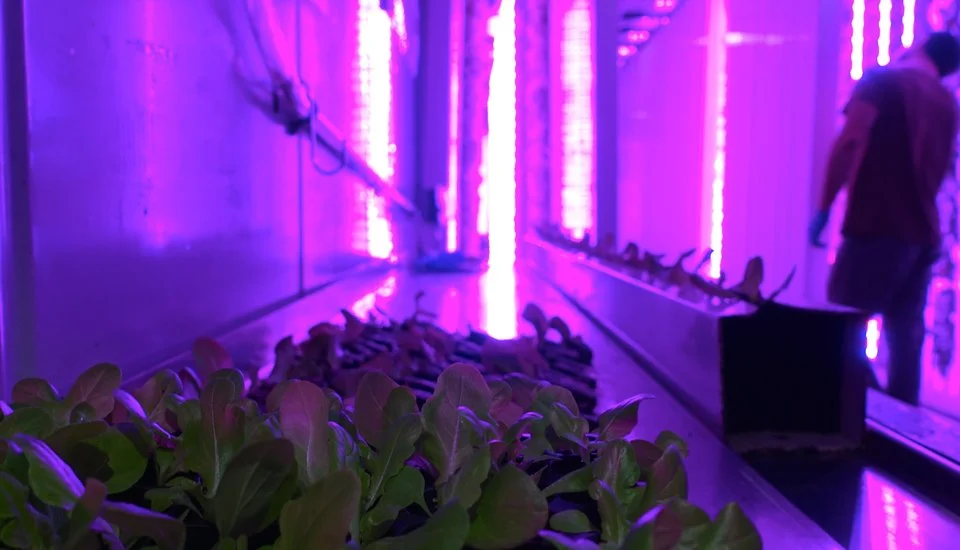‘Farm in a Box’ Could Protect Food Supplies After Extreme Weather Events
‘Farm in a Box’ Could Protect Food Supplies After Extreme Weather Events
Boston-based Freight Farms has developed what it calls the Leafy Green Machine, a method for vertical, hydroponic farming inside a shipping container.
BY MOLLY FOSCO | OCTOBER 16, 2017
Vertical and hydroponic farming has gained popularity in recent years. And with the frequency and intensity of some extreme weather events on the rise, innovative techniques offer enticing solutions to some agricultural problems.
Boston-based company Freight Farms is offering one approach: It’s helping people grow food inside shipping containers 365 days a year, no matter the weather conditions.
Brad McNamara and Jon Friedman started Freight Farms in 2010 with the goal of making it easier for anyone to grow food on a commercial scale. “We really focused on putting farming into the hands of regular people so that you can have a manageable footprint but still produce at a commercial level,” McNamara, the company’s CEO, told Seeker. “We were really inspired by what’s becoming possible with new technology and the fact that no one had changed their thinking yet from big agriculture and large-scale farms.”
McNamara and Friedman wanted to create something small that could still produce large crop yields. The result is the Leafy Green Machine, a produce farm that operates inside a shipping container that is forty feet long, eight feet wide, and nine and a half feet high. The LGM uses a vertical, hydroponic farming method that allows leafy greens like kale, lettuce, and cabbage, as well as herbs like basil, mint, and oregano, to be harvested once a week, year round. It grows 2-4 tons of produce annually using less than 10 gallons of water per day. Its water, air, and nutrient inputs can be monitored and controlled remotely using a software called "farmhand."
The LGM costs about $85,000 and around $13,000 to operate annually. Freight Farms offers financing options, as well as video tutorials and two-day, in-person trainings at their Boston headquarters on how to operate an LGM.
“The LGM is a really good tool for existing farmers to take some of the pressure off their farm infrastructure … and their native lands,” McNamara said.
Freight Farms is among other large and small companies embracing small-scale, vertical and hydroponic farming techniques. Metropolis Farms will open a solar-powered, 660-acre, indoor farm in Philadelphia next month, growing broccoli, strawberries, tomatoes, and lettuce in a 100,000-square-foot warehouse year round. And Ikea is developing a hydroponic farming system that will allow the furniture retailer to grow and harvest its own veggies in-house.
“We’ve had multiple waves of innovation within agriculture and to me this is just the next frontier that needs to be created,” McNamara said.
RELATED: Urban Farming Isn't a Game Changer When It Comes to Carbon Emissions
The Leafy Green Machine came in very handy when Hurricane Harvey destroyed crops across dozens of counties around Houston, Texas. Employees at Acre in a Box, a Houston-based hydroponic farm that uses the LGM, couldn’t get to their farm for several days after the storm due to flooding. However, because they were monitoring their crops remotely with the Farmhand app, all the plants remained intact.
“Eventually they were able to go in and harvest, and right as the restaurants they work with started to open, they were the only ones who could provide them with produce,” McNamara said.
In light of the recent, severe hurricanes like Harvey and raging, deadly wildfires in California, McNamara believes the LGM could be invaluable after future, extreme weather events.
“It’s always been an exciting use case for us, you know, the ability to take an area that’s been decimated by these increasing, more extreme climate events and allow it to bounce back,” he said. “If you look at what’s happening in Puerto Rico, their priorities are water, electricity, and food, and the traditional farming sector might take years to come back. But what do you do in the meantime?”
He added, “Everything we’ve built since the beginning, from the hardware to the software side of the business, has been to make it easier and more efficient for people to grow food where ever they are.”


